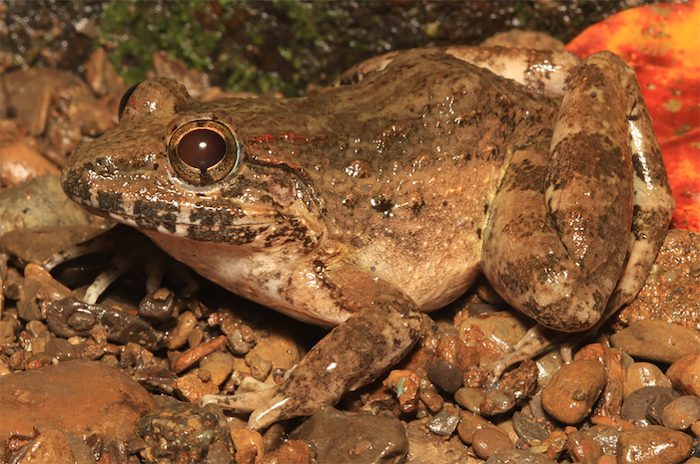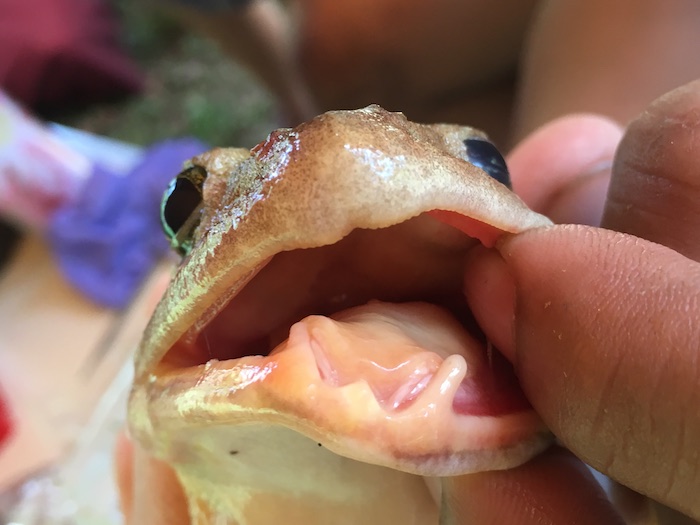SUMMARY
This is AI generated summarization, which may have errors. For context, always refer to the full article.

Scientists have found a new fanged frog species hiding in plain sight by studying their unique mating calls and genomic data.
Fanged frogs belong to the genus Limnonectes, a group of about 75 known species of frogs with unusually large teeth that are small or absent in other frogs. Eleven of the recognized species are found in the Philippines.
The discovery was published recently in peer-reviewed journal Ichthyology & Herpetology.
Limnonectes beloncioi or commonly as the Mindoro fanged frog was nearly indistinguishable from its relative found in Palawan called Acanth’s fanged frog.
“You can look at two different things, but to the human eye without intensive investigation they might seem the same,” Mark Herr said in a statement. Herr is a doctoral student at the Kansas University Biodiversity Institute and Natural History Museum, and Department of Ecology & Evolutionary Biology.
“So, we took a bunch of measurements of hundreds of these frogs – how long their digits were specifically, how wide the tip of their toe was, the length of one specific segment of their leg, the diameter of their eye – in order to compare populations statistically, even if we thought they look the same.”
Herr said they also ran statistical analyses on the body shape and size, and found nothing to differentiate the frogs based on these. But because these fanged frogs live on two different islands, Mindoro and Palawan, researchers had doubts that they were the same species. They also found something surprising, that despite their resemblance, their mating calls sound different from each other. This is what brought the researchers to study the frogs’ genome and determined the Mindoro fanged frog is its own distinct species.
“We found they’re related to each other, they are each other’s close relatives, but we found they’d been separate for two to six million years – it’s a really long time for these frogs. And it’s very interesting that they still look so similar but sound different,” said Herr.
A peek into Mindoro’s biodiversity
The relationship between Acanth’s fanged frog of Palawan and the Mindoro fanged frog is something interesting for biogeographers or someone who studies the evolution of species’ geographical ranges like Dr. Rafe Brown, a professor at the Department of Ecology & Evolutionary Biology at Kansas University. He is also the curator-in-charge of the Herpetology Division in the same university.
“The affinity among some of Palawan’s amphibian species and close relatives on Mindoro is not early biogeographers from the late 1800s would have predicted,” Brown told Rappler in an email.
In the past, researchers believed that Palawan’s plants and animals have come from Borneo, and that meant most of Mindoro’s species presumably originated in the northern Philippines.
“This translates to many explorers identifying species they encountered on Mindoro as the same species documented on Luzon; if exceptions were found, most were explained away as anomalies or just dismissed as a mistake,” said Brown.
But by the late 1990s, more scientists, particularly Filipinos and their international collaborators, had begun to utilize independent sources of data such as DNA sequences to infer evolutionary relationships of different organisms rather than rely on physical similarity.
“By focusing on diverse groups of organisms (other than just birds and mammals), and by incorporating independent sources of data, Palawan’s and Mindoro’s flora and fauna became recognized as a complex mixture of species, with an impressive variety of affinities,” said Brown.
“This evolutionary ‘cross roads’ or ‘melting pot’ pattern, is much more interesting and exciting for biodiversity specialists – in part because we get to figure out each species’ evolutionary origins,” he added.

The need for conservation
“The discovery reaffirms once again the unique and tremendous biological diversity of Mindoro Island and increased diversity and endemism in the country,” said Camila Meneses, a PhD aspirant at Kansas University and a researcher at the University of the Philippines Los Baños’ Museum of Natural History.
Moreover, discoveries such as this one highlight the need for forest conservation in Mindoro and in many other places.
“Mindoro Island is one of the islands in the archipelago that harbors a high number of endemic and endangered species based on past studies. Unfortunately, it is also one of the most severely deforested islands in the country. Forests in Mindoro are still under pressure despite the fact that several reserves have been established for so many years,” Meneses told Rappler in an email.
“This new discovery is unique to this island and cannot be found nowhere else in the world. That information alone can be a strong support to prioritize research, conservation, dissemination, and alleviate the tension and pressure of development due to many factors,” she said.
Meneses also said that the recent discovery emphasizes the still underestimated Philippine biodiversity.
“And if is still underestimated, complete and sustainable management plan will be at stake,” she said.
What this discovery offers is a window to more opportunities to propose and craft new policies to ensure the protection and conservation of these unique species and habitat, she also said. – Rappler.com
Add a comment
How does this make you feel?





There are no comments yet. Add your comment to start the conversation.